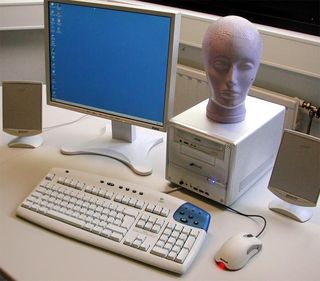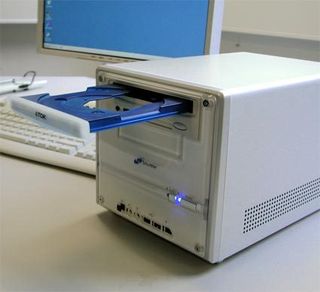Goodbye to Hulking PCs: Athlon Mini-PCs Set The Trend
A New Trend: Compact Mini-PCs For AMD Athlon

It's very compact, comes in a stylish case, and can still handle all tasks like the best of them. In addition, it manages to keep the noise level down, and this is where even the best of the biggies can't keep up. When compared directly, the little one sizes up quite well against the biggies: it takes up only about a fourth of the volume needed by the large ones. If you place the two PCs next to one another, the neutral observer will hardly be able to believe that the large PC with the awkward design represents the state of technology in 2002.

A modern workplace with mini-PC and a large TFT monitor.

High quality materials and workmanship with Shuttle's mini PC.
The motherboard is the main reason why conventional PCs don't come in a more compact form. Currently, most PC systems come with a motherboard in the ATX format. This form factor is characterized by its generous dimensions and its low integration density for components. So in order to get a more compact PC system, a motherboard with smaller dimensions is needed. The best foundations for mini PCs are motherboards in the Flex-ATX and Micro-ATX formats. At a fraction of the size of standard ATX boards, these models offer the same functionality: graphics; network; sound; FireWire (IEEE1394); TV-out; USB (versions 1.1 and 2.0); Ultra-DMA/100 connectivity; and digital audio-in/out. The only limitation is with the expansion of components: our test system from Shuttle has only two PCI slots. The manufacturer does away with an AGP slot, since the onboard graphics are sufficient enough for 2D applications. Nevertheless, Shuttle has announced that it will be coming out soon with a mini PC system equipped with an AGP slot - while maintaining the same compact dimensions. In our last test, Build Your Own Mini-PC For The Office , compact computers still looked quite different.

Mini-PC with an integrated CD recorder.
Stay on the Cutting Edge
Join the experts who read Tom's Hardware for the inside track on enthusiast PC tech news — and have for over 25 years. We'll send breaking news and in-depth reviews of CPUs, GPUs, AI, maker hardware and more straight to your inbox.
Current page: A New Trend: Compact Mini-PCs For AMD Athlon
Next Page Features: A Barebone System Without A CPUMost Popular

